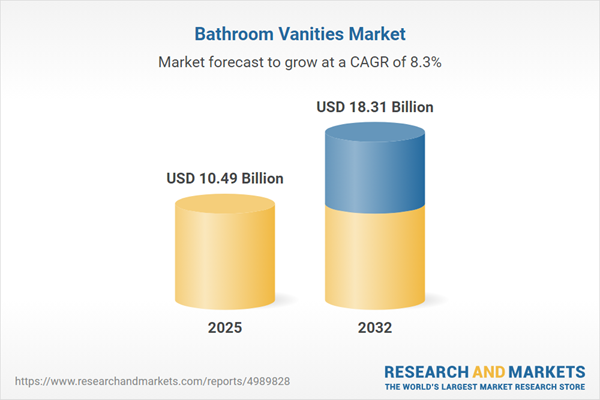Speak directly to the analyst to clarify any post sales queries you may have.
Senior decision-makers in the bathroom vanities market are navigating dynamic industry standards, evolving end-user preferences, and the increasing role of digital solutions in modern supply chains. Adapting quickly and staying informed ensures organizational competitiveness as the market continues to transform.
Market Snapshot: Bathroom Vanities Market Growth & Trends
The bathroom vanities market is steadily expanding, with its global value projected to increase from USD 9.70 billion in 2024 to USD 10.49 billion in 2025, and anticipated to reach USD 18.31 billion by 2032. Backed by a compound annual growth rate (CAGR) of 8.26%, this robust trajectory is influenced by growing demand for personalized product features, greater integration of smart technologies, and a strong emphasis on sustainability within product development.
Leading suppliers are responding by enhancing manufacturing innovation, investing in digital commerce infrastructure, and prioritizing responsible sourcing. This supports both residential and commercial client needs amid regulatory changes and shifting design expectations.Scope & Segmentation: Bathroom Vanities Market Overview
- Product Types: Console, freestanding, integrated, and wall-mounted vanities deliver flexible installation options suited to varied design themes and project requirements across contemporary, transitional, and classic spaces.
- Distribution Channels: E-commerce, direct-to-consumer, home improvement retailers, showrooms, specialty outlets, and third-party marketplaces widen B2B reach and enable procurement responsiveness across markets.
- Materials: Options such as laminate, resin, aluminum, stainless steel, stone, and assorted woods ensure durability, meet sustainability criteria, and support tailored project specifications.
- Price Ranges: Both value-focused and premium segments allow organizations to optimize sourcing while respecting budgetary frameworks and operational goals.
- End Users: The sector caters to hospitality, commercial office environments, institutional venues, and residential settings, each with distinctive functional, maintenance, and design expectations.
- Styles: Market offerings include industrial, modern, rustic, traditional, and transitional aesthetics, equipping architects and contractors to address renovations and new builds in line with emerging trends.
- Regions: Active engagement is observed in the Americas, Europe, Asia-Pacific, and the Middle East & Africa, with procurement behaviors and design influences evolving prominently in India, China, and Southeast Asia.
- Technology Use: Adoption of digital visualization tools, integrated smart features, automation, and advanced materials supports faster project delivery and enhanced customization for B2B clients.
- Market Leaders Assessed: The report benchmarks major players including Kohler Co., LIXIL Group, TOTO Ltd., Masco Corporation, Duravit AG, and regional specialists, analyzing innovation, supply network agility, and industry stature.
Key Takeaways: Strategic Insights for Senior Decision-Makers
- Modular and flexible product lines position suppliers to efficiently fulfill a broad spectrum of project needs and adapt to changing specifications from architects and designers.
- Investments in advanced digital procurement processes facilitate greater transparency and enable proactive supply management amid volatile demand.
- Commitment to responsible sourcing and environmentally conscious production enhances corporate alignment with institutional sustainability goals and appeals to compliance-driven buyers.
- The integration of smart features into bathroom vanities delivers differentiated user experiences and supports operational efficiency for forward-thinking organizations.
- Expanding distribution strategies across digital, retail, and direct channels helps organizations maintain supply continuity and increase market resilience in uncertain environments.
- Regional adaptation of go-to-market strategies in response to unique regulations and buyer preferences ensures solution relevance and strengthens compliance practices across target geographies.
Tariff Impact: Navigating U.S. Import Dynamics for 2025
New U.S. tariffs on bathroom vanity components are prompting executive teams to reassess sourcing models and streamline international supply chains. Proactive identification of new supplier partners and adjustment of process flows will be key to minimizing disruption and achieving compliance in this changing regulatory environment.
Methodology & Data Sources
This market analysis combines direct C-level interviews, comprehensive secondary research, and in-depth regional case studies. All findings are validated for relevance and accuracy, ensuring decision-makers receive actionable insights tailored to the realities of the industry.
Why This Report Matters: Bathroom Vanities Market Positioning
- Empowers leadership to strengthen sustainability initiatives, drive digital transformation, and refine procurement in fast-evolving and regulated environments.
- Delivers practical guidance for navigating complex sourcing, compliance, and operational challenges across diverse market landscapes.
- Enables the early identification of emerging opportunities, supporting agile responses as technologies and buyer needs advance within the sector.
Conclusion
This report equips senior leaders to steer product innovation, reinforce supply networks, and enhance organizational resilience as the bathroom vanities market develops in scale and complexity.
Additional Product Information:
- Purchase of this report includes 1 year online access with quarterly updates.
- This report can be updated on request. Please contact our Customer Experience team using the Ask a Question widget on our website.
Table of Contents
3. Executive Summary
4. Market Overview
7. Cumulative Impact of Artificial Intelligence 2025
Companies Mentioned
The companies profiled in this Bathroom Vanities market report include:- Kohler Co.
- Masco Corporation
- LIXIL Group Corporation
- TOTO Ltd.
- Roca Sanitario, S.A.
- Duravit AG
- Fortune Brands Home & Security, Inc.
- Geberit AG
- American Woodmark Corporation
- HCG Holding Co., Ltd.
Table Information
| Report Attribute | Details |
|---|---|
| No. of Pages | 181 |
| Published | October 2025 |
| Forecast Period | 2025 - 2032 |
| Estimated Market Value ( USD | $ 10.49 Billion |
| Forecasted Market Value ( USD | $ 18.31 Billion |
| Compound Annual Growth Rate | 8.2% |
| Regions Covered | Global |
| No. of Companies Mentioned | 11 |









